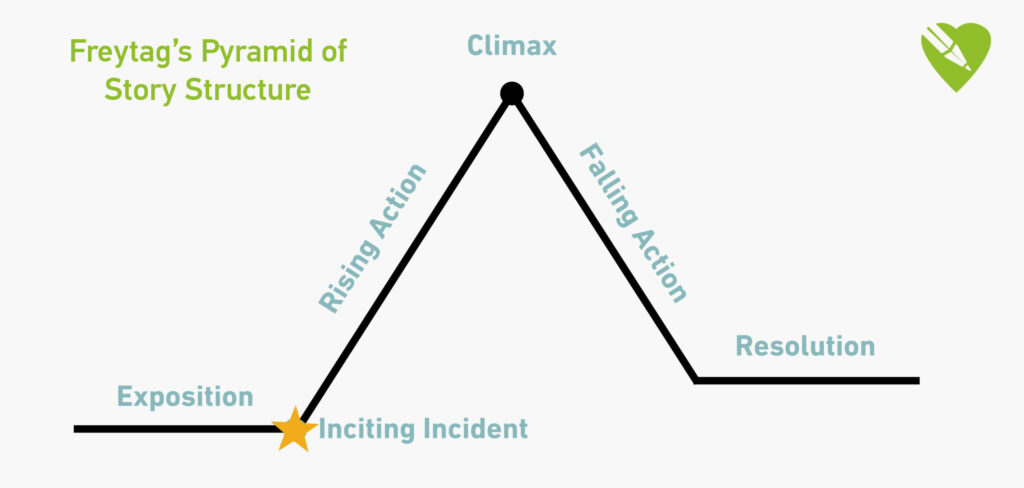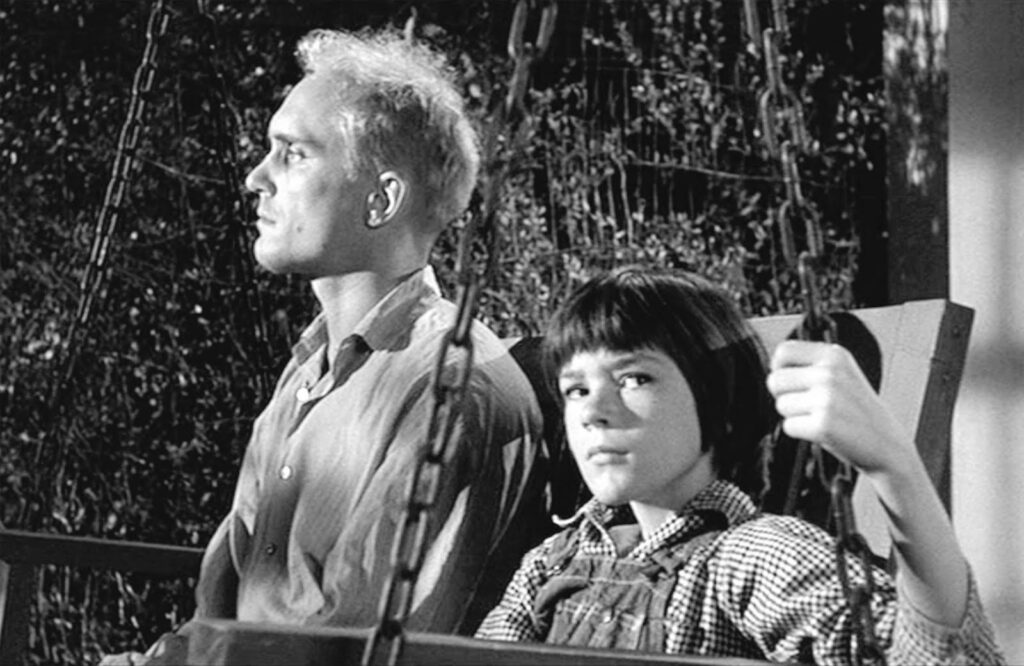All stories must eventually come to a conclusion, or “resolution.” As an author, your job is to ensure that the plot threads you weave, the characters you create, and the conflicts you build have a natural and satisfying conclusion. Resolutions are an essential part of storytelling. You don’t want to leave your audience with a “bad taste” at the very end of what could otherwise be considered a masterpiece.
Previously, we discussed the tried and tested Freytag’s Pyramid, a useful template for structuring stories. It includes five stages, starting from exposition and continuing through rising action, climax, and falling action before finally coming to the resolution. In this article, I will explore this final stage in its key elements, different styles, and I will give you a Story Weapon to help your readers close the final chapter of your story feeling satisfied.
A story’s resolution (the final stage of Freytag’s Pyramid) ties together loose ends, reveals the consequences of the climax, and gives readers emotional closure. It shows how characters and their world have changed, offering a satisfying sense of completion.
Table of Contents
Definition of Resolution / Denouement
In simple terms, the resolution or denouement is the final part of the story that occurs after the falling action. It serves to tie up loose ends, answer lingering questions, and wrap up the plot. The term “denouement” is French, meaning “unknotting,” “outcome,” or “finale.”
You might think of it as simply the ending, but the denouement goes deeper than that. It serves to show the new status quo once the plot has been resolved. In some stories, this is where the next installment is teased as well.

Purpose of the Resolution
Let’s talk about why writers put great emphasis on resolutions.
Closure
The resolution provides closure for the plot. Following the falling action, the end of your story should naturally develop from that. The conclusion gives clarity about what came before and what is to come next.
Consequences
The resolution shows how things have changed. Continuing from the previous point, the resolution allows readers to experience the effects of the climax and how it has shaped the characters, relationships, and the status quo.
At the denouement stage, your characters get a chance to reflect on the growth they have experienced, and the audience can also see how they have changed since the start of the plot.

Questions Answered
There might be many plot points in a story that the audience would want to have addressed. For example, the question of what will happen to the main character next is almost always a lingering thought for your reader or audience. This stage of the story serves to provide answers for that, although it might not answer ALL questions.
Satisfaction
The end of your story should give some form of satisfaction to the reader (while keeping true to the genre and tone). The resolution shows how the events of the plot fit into the broader scheme of the story and character’s journeys. It is a natural conclusion and serves as a reward for the audience’s emotional investment.
Key Elements of a Strong Resolution
To effectively nail a strong resolution, here are some key elements to consider.
- Restored balance or a “new normal”: The resolution should show how things have changed after the climax and how the new state of affairs looks.
- Emotional payoff: The resolution should tie up loose ends and complete the journeys of the characters to deliver a strong and satisfying emotional payoff.
- Final character insight or reflection: The characters should reflect on their journey and events in order to emphasize their growth and evolution. This also allows them to develop further should new chapters in the story be written later.
- Hints at the future: Speaking of new chapters, the resolution should introduce small plot threads to excite fans and build anticipation for the next chapter of the series. Small hints and references are effective and can seamlessly be integrated.
- Consistency in tone with the rest of the story: The resolution should reflect the tone of the overall story and be consistent with it. For instance, a grim dark story should have a tragic or bittersweet ending in order to be loyal to its tone.

Different Resolution Styles
There are a lot of different styles of resolutions. Let’s look at some and discuss their examples.
Neat and tidy
This is a simple and traditional way to close the story. It wraps up all major plot points with a satisfying and complete ending, where the conflicts are resolved, relationships are fulfilled, and the audience is left with a sense of closure and contentment. This is why it is most often found in romance and children’s stories.
For example, in Cinderella, the story concludes with the protagonist marrying the prince and living “happily ever after,” while the evil stepmother is left destitute and regretful (with even worse endings for the stepsisters in early versions of the story). This closes Cinderella’s arc on a good note and ties up all loose ends.
Bittersweet or tragic
These resolutions often involve a mix of satisfaction and sadness, but are no less complete. In them, the conflict does end, but often at a significant cost to the protagonists. Rather than giving a “feel-good” experience at the end of a story, these endings highlight the complexity of life, loss, or sacrifice. As such, they are more common in dramas and tragedies.
A great example of this would be Titanic. At the end, when the ship has sunk, Rose survives and carries the memory of Jack with her. Despite their love story ending in tragedy, there is emotional fulfilment and a satisfactory resolution.

Open-ended
An open-ended resolution leaves certain questions unanswered in order to preserve some mystery and intrigue. These endings invite the audience to imagine what happens next or interpret the ending themselves. This style is quite common in modern, philosophical, and ambiguous stories that emphasize themes over solid conclusions.
Perhaps the most famous example of this would be Christopher Nolan’s film, Inception. The story deals with the philosophy of dreams and our perception of reality, and fittingly, it ends on a confusing note. The resolution closes on a spinning top, leaving viewers to question whether Cobb is still dreaming or not.
Cliffhanger
A cliffhanger is an incomplete resolution that ends at a moment of high tension or unanswered conflict. These often set up a sequel or next installment in the franchise and keep the audience excited for more by hinting at what is to come.
A good example of a cliffhanger resolution would be in Avengers: Infinity War. Towards the end, the main antagonist, Thanos, wipes out half the universe, and the heroes are left hopeless after suffering major losses. This leaves fans desperate for the sequel in hopes of a complete resolution.
Checklist for a Satisfying Resolution
If you want to write a satisfying resolution to your story, be sure to follow these top tips:
- Reflect the journey and theme of your story: The resolution is the final part of the story and should reflect and align with everything that came before. Remain consistent with your themes and ideas right till the end.
- Show change: Because stories are all about change, the resolution should show how characters have developed during or after the climax. Showing growth is a great way to create dynamic characters.
- Don’t drag it out too long: Don’t unnecessarily drag out the ending. Some plot threads can be resolved naturally within the story, so you don’t leave it all for the ending. Only resolve the important plot threads in the denouement.
- Avoid introducing new conflicts: While it can be tempting to tease a sequel by introducing new conflicts, it can often detract from the ending of the story itself.
- Let the reader breathe after the climax: Most climaxes involve heart-pounding action or deeply emotional moments. Resolutions should provide a change of pace and, if possible, a moment of levity. This will help improve the overall reading experience by a huge margin.
Common Mistakes to Avoid
Despite the importance of the resolution, many intrepid authors often make the same mistakes. Here’s what to avoid when writing the denouement of your story.
- Ending too abruptly and not tying up loose ends
- Over-explaining
- Ignoring the emotional resolution of characters and their relationships
- Making the ending feel disconnected from the story, as if it were an afterthought
- “It was all a dream.” Done poorly, this type of betrayal can destroy the audience’s investment in the story and characters.

Your Story Weapon: Why Resolution Matters
All stories need a proper resolution. Even if a story continues in a future installment, each book, episode, or movie should have a self-contained arc with its own resolution. Stories are all about setup and payoff. If you set up a conflict, you need to pay it off in the end, too.
That doesn’t mean you should stop teasing the next installment. It is a good practice to give little hints for what’s next to keep audiences engaged and set their expectations. However, make sure that your story doesn’t end abruptly with no buildup.
Resolutions allow the audience to look back, to understand the full journey and why it mattered. In writing a compelling resolution, consider that your protagonist must make a difficult choice between what they want and what they need. Explore creative ways to dramatize this choice. Make sure that the choice is difficult — in other words, this is not a choice they would ever have been able to make in Act One. By dramatizing this choice, you will create the most satisfying of endings — one that is both a total surprise while being utterly inevitable.;
Want to learn more about story structure? Check out my workshops and see which one is the best fit for you: The 90-Day Novel, The 90-Day Memoir, Story Day.







